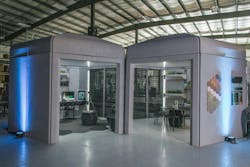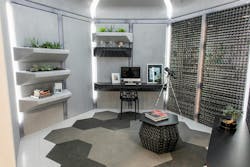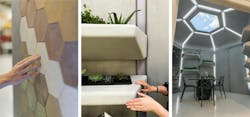In mid-November, NASA successfully launched an uncrewed capsule to orbit the moon. It was the auspicious start of the Artemis missions that aim to put people on the lunar surface, where humans last walked 50 years ago. But once they’re on the moon, where will people live?
One potential answer came into focus a few weeks before the Artemis launch, when Branch Technology, a Tennessee-based construction technology company, presented its 3D-printed lunar habitat prototype. Branch had 3D printed the entire two-room unit, including its walls, ceilings, and furniture. With NASA’s funding and expertise, Branch created the prototype in partnership with the UK-based design firm Foster + Partners and Stanford University. After starting in October 2021, the nearly $500,000 million prototype project concluded this month.
Branch’s relationship with NASA began years earlier. In 2017, along with Foster + Partners, Branch won the space agency’s competition to build a 3D-printed habitat for space.
For that project, Branch deployed a traditional 3D printing approach, in which a printer slowly deposits layer upon layer of feedstock material to create an object such as a wall. Typically, 3D printing or additive manufacturing, whether in construction or desktop, uses this extrusion method.
But it comes with a downside: The resulting object, while certainly strong, requires a large amount of printing material.
USING MATERIAL INNOVATIONS TO 3D-PRINT IN SPACE
After its 2017 project for NASA, Branch’s team members decided one value they could add to off-world operations would be material efficiency—using less material to print large volumes. This approach also would align with NASA’s interest in in-situ resource utilization, or using materials found on the moon’s surface.
“We have to make resources in space go as far as we can. It’s really expensive to launch feedstock materials from Earth,” says David Goodloe, program development manager for Branch’s advanced concepts team.
The idea of material efficiency runs counter to traditional 3D printing—but it’s precisely what’s achieved by Branch’s patented approach, which it calls cellular fabrication, or C-Fab.
With C-Fab, Branch’s 3D printers extrude material that solidifies in space while it’s being printed. “It’s like you trace your pen through the air and your ink solidifies in midair, but in this case, your pen is a 12.5-foot robotic arm on a 30-foot sliding track,” Goodloe says. Branch has 17 printer robots in its 50,000-square-foot manufacturing facility located in Chattanooga, Tenn.
Rather than creating a dense layer cake of material, Branch’s printers produce a lightweight lattice structure. As a result, Branch uses 20 times less material than a traditional 3D printer would require to make the same volume, Goodloe says. “That’s our fundamental innovation.”
Branch infills the interstitial spaces of the lattice structure with other materials, such as fire-rated structural insulation, to add functionality. And it coats the outside of the object with a thin laminate finish. For Branch’s commercial business, these modular panels get sent to the job site as building facades.
Another C-Fab advantage, Goodloe says, is the standardized process for creating mass customized structures. Branch’s printers can build geometrically unique objects for the same cost as the same number of geometrically identical objects.
“That allows for incredible architectural design freedom. That’s a huge step forward from other manufacturing and construction processes that depend on repeated patterns,” Goodloe says. “It’s one process, one machine, and one set of algorithms, but it can be used to solve a host of challenges in a variety of arenas.”
C-Fab can print not only large objects such as wall panels but also very small ones, like the connectors that join the panels together. This capability allowed every single item in the NASA prototype’s hexagonal rooms, about 15 feet tall and 15 feet wide, to be 3D printed.
With its NASA prototype, Branch has demonstrated that a lunar habitat could be built using feedstock material sourced in space. On the moon’s surface, the habitat would be placed within a larger, pressurized container.
Next up? Branch plans to work with NASA on another research project that likely will involve adapting 3D printers so they can use materials available in space. “Our hope is actually sending a payload up to the moon to demonstrate this in zero gravity,” Goodloe says.


